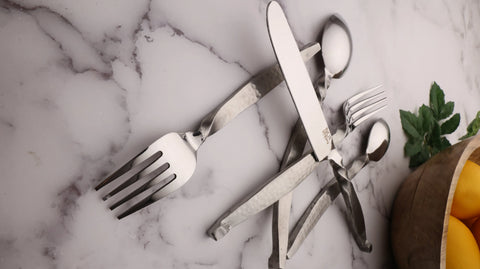It can be very confusing for first-time buyers to understand the terms related to flatware. What is 18/10? Should I invest in stainless steel? What about silver? Do you need something durable? Do you need something lightweight? Are you searching for something that doesn't dull with time? Are you finding something that doesn’t corrode easily? Tragically, you can't have everything, so you have to settle on what your needs are. In this article, we'll be evaluating the various sorts of Stainless Steel Flatware.
History of Flatware
Spoons, forks, and knives have generally been made with silver because of its anti-bacterial as well as anti-fungal properties. In contrast to other heavy metals, silver isn't poisonous. Furthermore, it can distinguish arsenic poisoning, on account of its response to sulfur-based compounds, of which arsenic poison contains.
It wasn't until the 1970's when forks and spoons began to be formed using stainless steel. Because of the consistent development of antibiotics, we had the least requirement of anti-microbial properties of silver in our flatware. Stainless steel flatware rose as the more affordable choice. Different reasons made stainless steel stand apart, for example, its resistance to rust as well as its longevity much under high temperatures.
Flatware Terms
This language was made by flatware manufacturers. The first number refers to the amount of chromium and the second number refers to the amount of nickel in the stainless steel alloy. Alloy is a metal that is made by blending at least two metallic components for strength or corrosion resistance. Steel makers add chromium and nickel to steel to make it more impervious to rust, yet an excessive amount of chromium and nickel will make the metal softer. Adding carbon to the steel alloy will make it powerful, however, less resistant to rust.
This is the reason knives are generally more inclined to rusting. To be sufficiently strong to keep a more keen edge longer, it needs to sacrifice a few of the chromium and nickel that provides stainless steel with its rustproof properties. Since it's less significant for spoons and forks to keep an edge, they are made with a softer grade of stainless steel that is highly corrosive resistant.
18/8 and 18/10
You may find both of these categories different, but 18/8 and 18/10 are almost the same. It was an advertising trick made by marketers to separate their product from competitors. It is exactly the same stainless steel alloy. While buying stainless steel from a steel mill, they are buying grade 304 stainless steel which has a range of 18-20% chromium as well as 8-10% nickel. Grade 304 stainless steel just has 0.08% carbon.
18/0
18/0 stainless steel is somewhat less corrosive resistant than 18/8 or 18/10 stainless steel due to the absence of nickel. Apart from being rustproof, Nickel additionally prevents staining. However, it is still just as sturdy as other grades of stainless steel that makes it an extraordinary alternative for restaurants that are on a budget. 18/0 is grade 420 stainless steel.
Is stainless steel safe?
Stainless steel is among the most common materials found in kitchens today. It's utilized in everything from machines to cookware, dishware, flatware and utensils since it is durable and corrosion-resistant to distinct acids found in meats, fruits, milk, and vegetables.
Inox Artisans has an immaculate collection of flawlessly crafted Antique Copper Flatware set, full polished antique flatware set, copper antique hammered urban flatware and so on that makes your dining table look more interesting and graceful.



